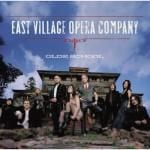
The East Village Opera Company’s goal — to rework opera songs as straightforward rock songs — is an interesting but unattainable one. An inherent conflict of interest exists, as on its 2005 self-titled release, the band often ended up in the uneasy middle, satisfying neither rock nor opera fans. What saved the album? Both its sheer novelty and the almost ramshackle attitude the band brought to the proceedings. The group seemed like a bunch of talented musicians who had this crazy idea while hanging out one day, and the best tracks from that album — covers of “Le Nozze di Figaro”, “La Donna é Mobile” and “O Mio Babbino Caro” — were loose, fun things. Even the album’s cover reflected that attitude: an out-of-focus photo of a beat-up violin on a grimy New York street corner.
The band’s second album, Olde School, seems a more-planned affair, from the music to the costumed pose the band strikes on the cover. One can’t help but think the whole thing was little more than a technical exercise — a triumph of form, rather than feeling.
Case in point: its take on Wagner’s “Ride of the Valkyries”, which opens the album. The infamous opening theme has been awkwardly bent to echo the riff from Zeppelin’s “Black Dog”, but before long the song dissolves into a slow, string-laden thing strangely reminiscent of Elton John’s “Funeral For A Friend”. The theme reappears near the end, only to segue into a “Hey Jude”-style slow fade out (complete with na-na’s!). It’s as though the band wanted to establish its rock-and-roll cred up front, so they sat down and figured out how to cram as many different rock songs into it as they could. But the end result somehow doesn’t sound like a rock song.
The feeling the band tries too hard persists throughout Olde School: the vocoder on “Brindisi Libera”, the spoken-word rap section in “Soldiers” and the R&B horn breakdown at the end of “Walk”. The kitchen-sink approach comes off not as irreverent but instead as somewhat soulless, and each carefully executed rock trope reinforces the suspicion the band works more on autopilot than anything.
A few exceptions worth noting: “Help Me (Jove, In Pity)” is lovely and bouncing with a sly clarinet joining the mix; “You’re Not Alone”, which was taken from a Bach cantata, brings the band its closest to an original tune; and the closer, the duet from Madame Butterfly, stays close to its opera roots for most of it’s eight-minute run time, making the thunderous introduction of the electric guitar justifiably epic.
The East Village Opera Company’s approach has earned them a lot of accolades over the course of its career and rightly so: They’re good musicians doing something relatively unique and rare. But would anyone listen to them if they were doing straight rock? (Or straight opera, for that matter?) Here’s hoping, for the band’s sake as much as anyone’s, they don’t plan out anything before heading into the studio next time. The East Village Opera Company seems better when they’re working off-the-cuff.

![Call for Papers: All Things Reconsidered [MUSIC] May-August 2024](https://www.popmatters.com/wp-content/uploads/2024/04/all-things-reconsidered-call-music-may-2024-720x380.jpg)



